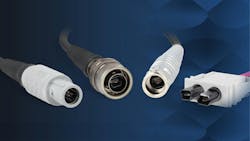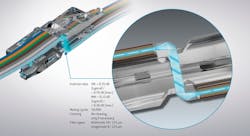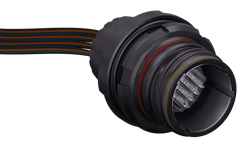Expanded Beam Fiber Optics: Zero-Maintenance Connectivity
What you’ll learn:
- How VITA standards enable seamless fiber-optic integration.
- The advantages of Expanded Beam Performance (EBP) technology.
- Future-proofing embedded systems with next-gen fiber optics.
In the rapidly evolving world of embedded-system design, the integration of next-generation technologies into existing infrastructures presents a significant challenge. Increasing demand for higher data-transmission rates necessitates the adoption of advanced interconnect solutions that can seamlessly replace outdated components without extensive system overhauls.
VITA (VMEbus International Trade Association) open standards have been instrumental in facilitating this transition, offering frameworks that support the integration of modern technologies into established systems.
In the past decades, fiber solutions have become more important to transmit these higher data rates. Initially, discrete fibers were used and installed into connectors made for harsh environments, such as 38999 housings. About 20+ years ago, this changed with the introduction of so-called MT ferrules.
Such ferrules are derived from MTP/MPO connectors, which have been a longtime staple in large-scale data centers. With this ferrule, it was suddenly possible to drastically shrink the size of fiber connectors. Prominent examples are backplane connectors, as described in VITA 66, and 38999-based circular connectors, as described in VITA 89.
The reduction in size came at a price: This ferrule was never designed to operate in harsh environments, and it has a high sensitivity to dust and dirt combined with a limitation in mating cycles. As a result, it needs to be cleaned before every mating cycle, which is a burden to the end-user.
Integration Alternatives with Durability
To address this, the VITA community is developing more durable alternatives with the new VITA 95 and VITA 96 standards. Aligned with the open standard philosophy, these solutions allow for simple integration via identical cut-outs. The key difference lies in a new lens-based contact system that offers excellent attenuation values over several thousand mating cycles without the need for cleaning. This innovative approach is exemplified by Expanded Beam Performance (EBP) technology developed by ODU.
The light signals are expanded via a lens system before traversing an air gap and being refocused in the receiving contact element. As a result, the system is less susceptible to contamination from dirt and dust and doesn’t require regular cleaning. ODU's EBP solutions bring to the table very high data rates and transmission speeds, even under harsh conditions. The durable fiber-optic solutions with EBP maintain their high performance even up to 50,000 mating cycles.
Expanded Beam Performance technology (Fig. 1) is an advanced fiber-optic solution that offers high-end transmission characteristics over many mating cycles. The optical performance remains unchanged even under mechanical stress, environmental influences, and harsh ambient conditions. Since there’s no direct contact between the contact ends, Expanded Beam connections are insensitive to soiling and are easy to clean. No cleaning is required under normal conditions.
Single- and Multi-Mode EBP
ODU's EBP technology is available in both single-mode and multi-mode versions. Due to its small size, the ferrule can be integrated into circular as well as backplane connectors.
At the heart of the new portfolio is a cassette system that enables multiple ferrules to be arranged side by side in a space-saving manner. With 12 connected fibers per ferrule, 96 optical fibers or more can be connected in one connector. The technology is available in classic I/O circular connectors and backplane connection systems in accordance with the upcoming VITA standards 95 and 96.
The ODU AMC Series T (Fig. 2) features a 3-in-1 locking system, non-reflective surface, and high resistance to external influences. The advanced metal connector is 38999 qualified and is available with a push-pull or thread mechanism, providing data integrity with a smaller outer diameter and high fiber density.
Adopting Next-Gen Fiber Optics
In conclusion, the integration of next-generation fiber-optic technologies into existing systems is essential to meet the growing demands for higher data-transmission rates and enhanced performance. The VITA open standards, particularly VITA 95 and VITA 96, provide a robust framework for this integration, enabling seamless replacement of outdated components with advanced solutions like ODU's EBP technology. By adopting these innovations, industries can achieve reliable, high-speed data transmission with reduced maintenance efforts, ensuring long-term operational efficiency and cost savings.
For a visual demonstration of how Expanded Beam Technology works, check out this video:
About the Author
Thomas Mittermeier
Strategic Business Development Manager for Aerospace/Military Fiber Optic Applications, ODU-USA
Thomas Mittermeier is the Strategic Business Development Manager for Aerospace/Military Fiber Optic Applications at ODU-USA, specializing in advanced connectivity solutions.


